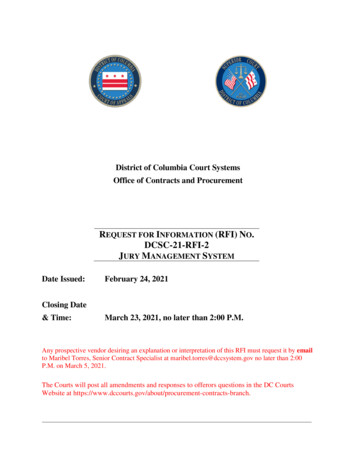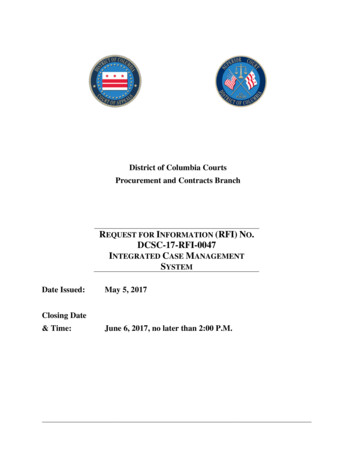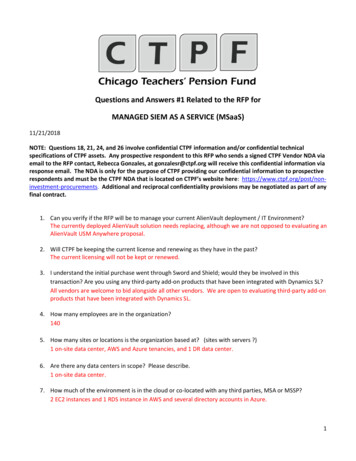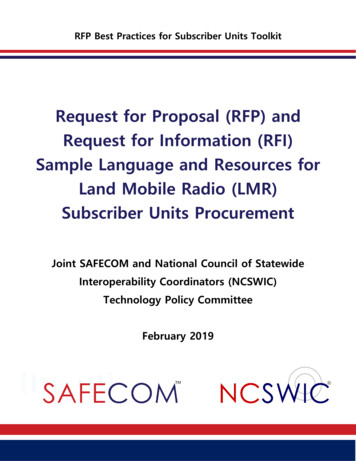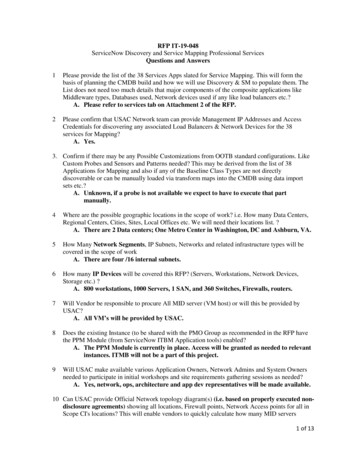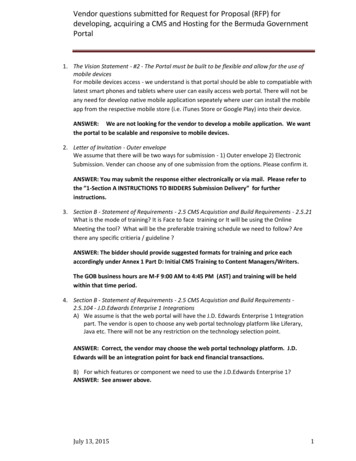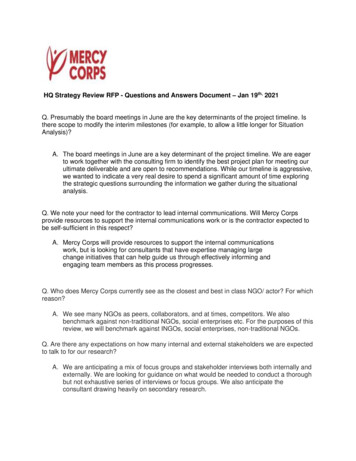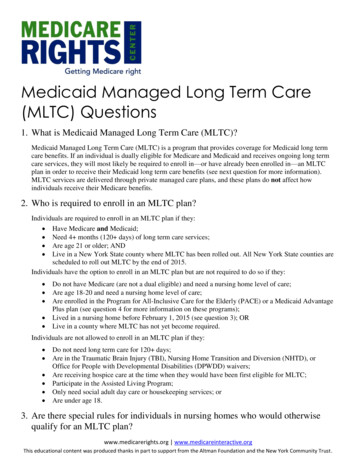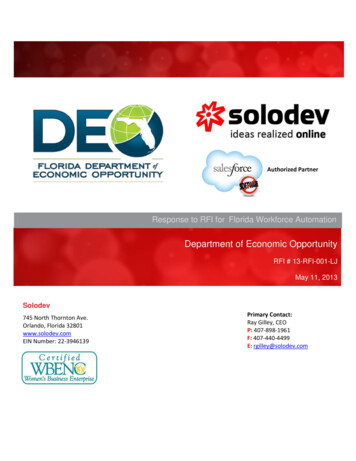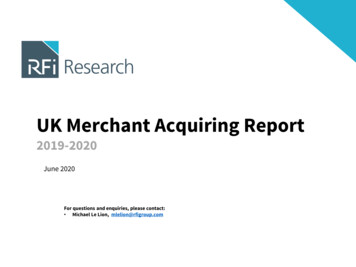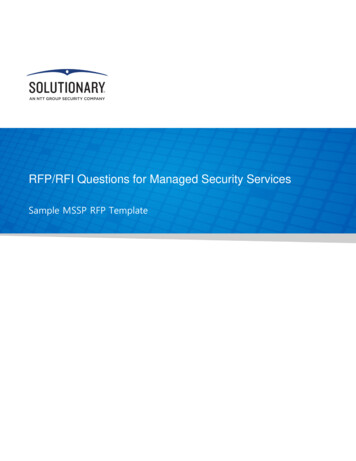
Transcription
RFP/RFI Questions for Managed Security ServicesSample MSSP RFP Template
Table of ContentsRequest for Proposal Template Overview1Introduction . 1How to Use this Document . 1Suggested RFP Outline3Company Background. 3RFP Objective and Project Overview . 3Proposal Instructions and Timelines . 3Proposal Response Outline . 4Client Requirements. 4RFP Sample Questions for Managed Security Services1.2.3.4.5.6.7.8.9.10.5MSSP Overview . 5MSSP Services Overview . 5Log Monitoring . 5Device Management . 6Vulnerability Management . 6Threat Intelligence . 7Incident Response . 7Reporting and Portal . 7Implementation and Customer Service . 7Optional Services . 7About Solutionary8
Request for Proposal Template OverviewIntroductionIn order to request services from a Managed Security Services Provider (MSSP), many organizations create aRequest for Proposal (RFP). This gives a number of MSSPs the opportunity to submit information on how theycan assist the organization with their IT security needs as well as provide the pricing for their services.This document is designed to assist with writing an RFP for MSSPs. The document outlines a sample RFP andvarious questions to use as a template for a RFP. The different sections are designed to convey information aboutan organization and the services the organization expects the MSSP to provide, as well as setting expectationsabout the partnership.The first section, “Suggested RFP Outline” contains the RFP section headers. “RFP Sample Questions” outlinesquestions to potentially ask an MSSP. Keep in mind that the fewer questions asked, the shorter the response willbe. So only use the questions that are the most relevant to the organization’s individual needs.Together, these two sections will develop a RFP template for Managed Security Services and also help theorganization find the best MSSP for their needs.How to Use this DocumentFor a copy of this document inUse the document as needed to get the necessary information to makeMicrosoft Word format, emailan informed decision. Make sure to delete any generic information andsolutionarynews@solutionary.com.replace it with specific content, based on the organization’s needs.Specific areas to modify and customize include: Headers that are specific to this document, such as “Request for Proposal Template Overview”,“Suggested RFP Outline” and “RFP Sample Questions.” Delete any questions not relevant to the organization in the “RFP Sample Questions” section. TheMSSPs will be required to respond to those questions, so make sure they cover all the informationnecessary to make a decision. Read through and customize the five sections under “Suggested RFP Outline.” This entire section willneed to be specific to the organization and should include the information necessary for the MSSP torespond to the RFP.The most important part of the RFP process is to be clear with expectations. The more information conveyed tothe MSSPs, the better a response they can submit. A common mistake organizations make when writing an RFPfor managed security services (MSS) is not listing all of the technologies in their environment that the MSSP willmonitor or manage, including the quantity and type (model number) of each in-scope technology platform. Withoutthis information, an MSSP won’t be able to give the best response. They may have to make assumptions aboutthe environment, which could impact the pricing and services they’re submitting.In addition, RFPs that are short and concise are typically the best options for the requesting organization and theMSSPs responding. Keep in mind what information is actually necessary for an RFP, and what can be done in anon-site presentation. Many organizations just use a template, without thinking about what type of response theywill get back.A 100 plus page response from an MSSP can be overwhelming, a strain on personnel resources and essentiallyuseless because it just has too much information to go through, whereas a 30 page response with the exactinformation needed can expedite the process immensely.RFP Template for Managed Security Services1Solutionary
Choosing the right MSSP partner is an important decision in an organization’s overall security program. Writing anRFP is the first step in the process to finding the right fit for the organization. Using this document, an organizationshould be able to write a tailored RFP that will help make the best and most knowledgeable decision possible.The companion documents Solutionary recommends for creating an RFP are listed below. For yourcomplimentary copy contact: solutionarynews@solutionary.com1. How to Choose an MSSPThis document lists items to consider when choosing between MSSPs and discusses details on criteriafor successfully choosing an MSSP.2. Solutionary white paper - How to Write an MSSP RFPThis white paper gives tips and suggestions for writing an RFP, poses several questions for theorganization to address prior to the RFP process as well as provides a list of the top 25 RFP questions toask an MSSP.RFP Template for Managed Security Services2Solutionary
Suggested RFP OutlineCompany BackgroundDescribe the company - history, employee count, size of the environment, number of locations and any otherrelevant information pertaining to the requirements of the RFP. Particularly, describe how security and complianceinformation will be managed and consumed by the organization, whether the structure is centralized ordecentralized and what groups or departments exist within the IT organization. This will give the MSSPsinformation about the organization, so they can tailor their proposed solution to match the any specific needs.RFP Objective and Project OverviewIn this section, state why the company is considering an MSSP service. Explain any specific requirements orneeds. The RFP objective should be clear enough that any company receiving the RFP will know if they are agood fit for the request.Also, include a list of all the technologies in the environment that the MSSP will monitor or manage. Make sure toinclude the quantity and type (model number) of each in-scope technology platform. This section should includeas much information about the environment as possible to give the MSSP a solid understanding of what will beexpected throughout the partnership.Proposal Instructions and TimelinesThe proposal instructions and timeline are needed to set clear expectations of the RFP and the format of theresponse. This section will include the date and time the RFP is due, who the RFP response will be sent to, andany font or formatting requirements. It should also include any additional information for the MSSP, such as thedeadline for the intent to propose, a deadline for questions to be submitted, when the questions will be addressed,any vender onsite presentations and dates for the final decision.List the point of contact for all RFP related questions and information on where to send the completed RFP. Anyspecial requirements can be listed in this section as well, such as if the completed RFP must be mailed (providedin hard copy) or can be sent via e-mail (electronic copy). If hard copy is requested, make sure to include anyrequirements for the number of printed and/or electronic (flash drive) versions.Point of Contact for RFP related Questions:Name:Title:Email Address:Phone Number:Please submit the RFP by email to the following:Name:Title:Email Address:Phone Number:RFP Template for Managed Security Services3Solutionary
Below is a suggested timeline:ActivityRFP DistributionIntent to ProposeQuestions DueQuestion ResponsesProposals DueVender Onsite PresentationsDecisionDate and TimeDate/Time DistributedApproximately 3 business days after distributionApproximately 5 business days after distributionApproximately 8 business days after distributionApproximately 14 business days after distributionApproximately 10 days after proposals dueApproximately 30 days after proposals have been submittedProposal Response OutlineThis section outlines the RFP response and describes what is expected in each section. Make sure to indicateany specific requirements that the RFP response needs to follow. An MSSP will follow this outline whenresponding to the RFP. Consider providing an outline of the type of response desired, as described below:1. Table of Contents2. Executive Summary: Brief introduction and overview of the Proposal. Explain how the MSSP will assistwith the IT security posture of the company. Please limit the executive summary to 5 pages.3. Services Overview: Brief overview of the services being proposed.4. RFP Requirements: Respond to all questions in the requirements section. Give a detailed response toeach of the questions or indicate that the proposed solution does not meet the requirements of thequestion.5. Pricing: Provide a detailed list of the pricing for the MSSP services. Include any options that may beavailable and explain how the pricing was calculated. Make sure the explanation of pricing matches theservices requested and that all vendors are providing a similar level of service.6. Appendix: Any relevant information not addressed in the RFP Requirements, including any optionalservices.Client RequirementsPlease see the next section in this document labeled “RFP Sample Questions” for suggestedquestions/requirements.RFP Template for Managed Security Services4Solutionary
RFP Sample Questions for Managed SecurityServicesThese questions were written based on various requirements for Managed Security Services Providers (MSSPs)and will enable an organization to determine the best MSSP to partner with. Please remove any questions thatare not relevant to the organization. The more questions in an RFP, the longer the response. A shorter, moreconcise response with less questions will be easier to review and compare MSSPs.1. MSSP Overview1.1.1.2.1.3.1.4.1.5.1.6.1.7.Please give a brief company description. Include how long the company has been providing MSS.Please outline the proposed services.Please describe any awards your company has won.What industries do you provide services to?Does your company have tiered service levels? If so, please list them here.Has your company successfully completed an SSAE 16 SOC1 Type II Audit?Explain you disaster recovery plan.2. MSSP Services Overview2.1.2.2.2.3.2.4.2.5.2.6.Describe the groups delivering the proposed services including the group name, whether they are inhouse or partner staff, their qualification/certification process, their geographic location and theavailability of personnel (24/7, 8/5, etc.).Describe at a high level the general process flows for the proposed services. Explain any significantexceptions and differences that exist between service tiers.Do you use your own technology, third party products or a combination for service delivery? Describethe technologies, products and tools used to deliver each of the proposed services. Describe anypatents your technology has been awarded.Will any hardware need to be installed to support the proposed services? If so, what specific hardwareand who will install, maintain and manage the hardware?Will any software need to be licensed and/or installed to support the proposed services? If so, whatspecific software and who will install, maintain and manage the software?Describe your SOC and the level of support it provides. Please include your SOC qualifications andcertifications.3. Log Monitoring3.1.3.2.3.3.3.4.3.5.3.6.3.7.3.8.Do you provide log monitoring services to your clients? If so, describe your log monitoring capabilitiesand service tiers.Are you able to accept feeds from security devices, network devices, applications, endpoints anddatabases? Describe the devices your solution supports.Describe your process for identifying the security relevant events from these feeds and explain, forexample, the types of events you process from (both) a Windows host (and organizationally criticaldevice) and how the event information can be used within your correlation and rules engine.Do you enrich log data with contextual elements such as IP reputation, Geo IP or assets?What are your analytic and correlation capabilities? Describe the continuum from automated processingthrough human validation and identify the hand-off between the two.Can you analyze and correlate data to identify security events and classify events according toseverity?Can you correlate across multiple device types in a client environment? If so, how specifically is thisaccomplished?How does device and environmental context factor into the identification, validation and escalation ofsecurity incidents?RFP Template for Managed Security Services5Solutionary
3.9.3.10.3.11.3.12.3.13.3.14.3.15.3.16.Are you able to correlate events across clients?Can you correlate events by identity (user)?Do you have advanced threat detection capabilities?Describe how you detect threats. Do you use signatures, behavioral analysis, anomaly detection,volume analysis or malicious host detection?Do you have the ability to identify malicious hosts? If so, please explain the scope and mechanism(s)used to do so.Can log data be stored for one year (at least 90 days online)?How does your company incorporate unsupported devices? What is your process for adding newdevice support?Do you have a customized escalation process for alerts? If so, please explain.4. Device Management4.1.Do you manage devices on behalf of your clients? If so, describe your device management capabilitiesand service tiers.4.2. Describe the mechanism(s) available to request changes to a managed device.4.3. Do you provide for the concept of “normal” changes vs. “emergency” changes? Describe howemergency changes are handled differently than normal changes.4.4. Do you offer shared device management/co-management of devices? If so, describe the model usedand any requirements or limitations.4.5. Describe the on-boarding process for taking over management of new devices. What reviews,validations or rationalizations are performed on the device configuration and health?4.6. Describe the support and assistance you can provide in moving from a traditional IP/network policybased firewall to a protocol/application policy (next-generation) based firewall?4.7. How is troubleshooting handled as part of the device management service?4.8. Describe your policy and process for validating changes requested to a managed device.4.9. List the certifications/experience of the security engineers that will be managing the devices for theservice proposed.4.10. How are projects such as major version upgrades, vendor changes, and client infrastructure changeshandled within the device management service?4.11. Describe the relationships that you have with the device vendors included in the proposed services thatensure you are aware and understand device and software changes.5. Vulnerability Management5.1.5.2.5.3.5.4.5.5.5.6.5.7.5.8.5.9.Do you provide vulnerability management services to your clients? If so, describe your vulnerabilitymanagement capabilities and service tiers.Do you integrate with third-party vulnerability scanning services? If so, please describe which servicesand how.Are you an approved PCI ASV? If so, describe the features of your vulnerability management servicesthat help meet PCI compliance.Do you provide managed application layer vulnerability scanning? If so, describe your applicationscanning capabilities and service tiers.Describe your configuration, scoping and scheduling capabilities. Explain what is user configurable vs.what must be configured by you.If we choose to use our own vulnerability scanning tool, does your system allow vulnerability scanningresults to be uploaded? If so, which vulnerability scanners are supported?Do you provide managed vulnerability result validation as part of your vulnerability managementservices? If so, describe how this validation is accomplished.Do you provide a vulnerability lifecycle management capability? If so, describe the granularity withwhich vulnerabilities can be managed — how they can be assigned to appropriate groups, how theycan be dispositioned and any auto-processing performed by the system to validate the disposition.Can your system correlate vulnerability scanning results with event data to provide on-target/off-targetstatus and an impact analysis rating?RFP Template for Managed Security Services6Solutionary
6. Threat Intelligence6.1.6.2.6.3.6.4.6.5.6.6.Do you have a dedicated team for security research? If so, describe the focus of the research.How does the research performed by your team directly impact the services delivered?What feedback mechanisms exist within your services to capture threat intelligence?List the proprietary and third-party intelligence feeds that are integrated into the proposed services.Does your security research team develop threat reports? If so, how often? Please attach any relevantreports.Do you have partnerships with technology and service providers to keep updated with the latest alertsand notifications?7. Incident Response7.1.7.2.7.3.7.4.Do you have critical incident response services? If so, describe the different types / tiers of serviceavailable.How is your incident response team integrated into the service delivery teams, particularly the logmonitoring team?Do your customers that subscribe both to log monitoring and incident response services receive anadvantage as a result? If so, how do you achieve that advantage?Describe your capabilities during an incident response engagement including incident management,evidence gathering, malware and forensic analysis capabilities, law enforcement interfaces and expertwitness capability.8. Reporting and Portal8.1.8.2.8.3.8.4.8.5.8.6.8.7.8.8.8.9.Describe your reporting capabilities.Can you support ad-hoc reports?Can you create custom reports? If so, under what terms and conditions?How do you support audit/compliance requirements?Do you have a separate portal interface for clients, or is it the same interface that the SOC analystsuse?Provide example screenshots of the portal UI for the proposed services.Does your portal provide t
RFP Template for Managed Security Services 2 Solutionary Choosing the right MSSP partner is an important decision in an organization’s overall security program. Writing an RFP is the first step in the process to finding the right fit f
